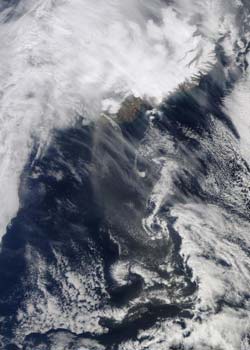NASA's Terra satellite keeps eye on Eyjafjallajökull's ash plume

The MODIS instrument on NASA\'s Terra satellite captured a visible image of the ash plume (brown) drifting south and east from Eyjafjallajökull volcano in Iceland at 11:55 UTC (7:55 a.m. EDT). Credit: NASA\'s MODIS Rapid Response Team<br>
The Moderate Resolution Imaging Spectroradiometer (MODIS) instrument on NASA's Terra satellite captured visible image of the ash plume (consisting of fine particles of pulverized rock) at 11:55 UTC (7:55 a.m. EDT). The plume appeared to be lighter in color than the previous few days, and it was drifting south and east over the Northern Atlantic Ocean.
NASA works with other agencies on using satellite observations to aid in the detection and monitoring of aviation hazards caused by volcanic ash. For more on this NASA program, visit:
http://science.larc.nasa.gov/
asap/research-ash.html
The MODIS Rapid Response System was developed to provide daily satellite images of the Earth's landmasses in near real time. The MODIS Rapid Response Team that generates the images is located at NASA's Goddard Space Flight Center in Greenbelt, Md.
Media Contact
More Information:
http://www.nasa.govAll latest news from the category: Earth Sciences
Earth Sciences (also referred to as Geosciences), which deals with basic issues surrounding our planet, plays a vital role in the area of energy and raw materials supply.
Earth Sciences comprises subjects such as geology, geography, geological informatics, paleontology, mineralogy, petrography, crystallography, geophysics, geodesy, glaciology, cartography, photogrammetry, meteorology and seismology, early-warning systems, earthquake research and polar research.
Newest articles

Bringing bio-inspired robots to life
Nebraska researcher Eric Markvicka gets NSF CAREER Award to pursue manufacture of novel materials for soft robotics and stretchable electronics. Engineers are increasingly eager to develop robots that mimic the…

Bella moths use poison to attract mates
Scientists are closer to finding out how. Pyrrolizidine alkaloids are as bitter and toxic as they are hard to pronounce. They’re produced by several different types of plants and are…

AI tool creates ‘synthetic’ images of cells
…for enhanced microscopy analysis. Observing individual cells through microscopes can reveal a range of important cell biological phenomena that frequently play a role in human diseases, but the process of…





















